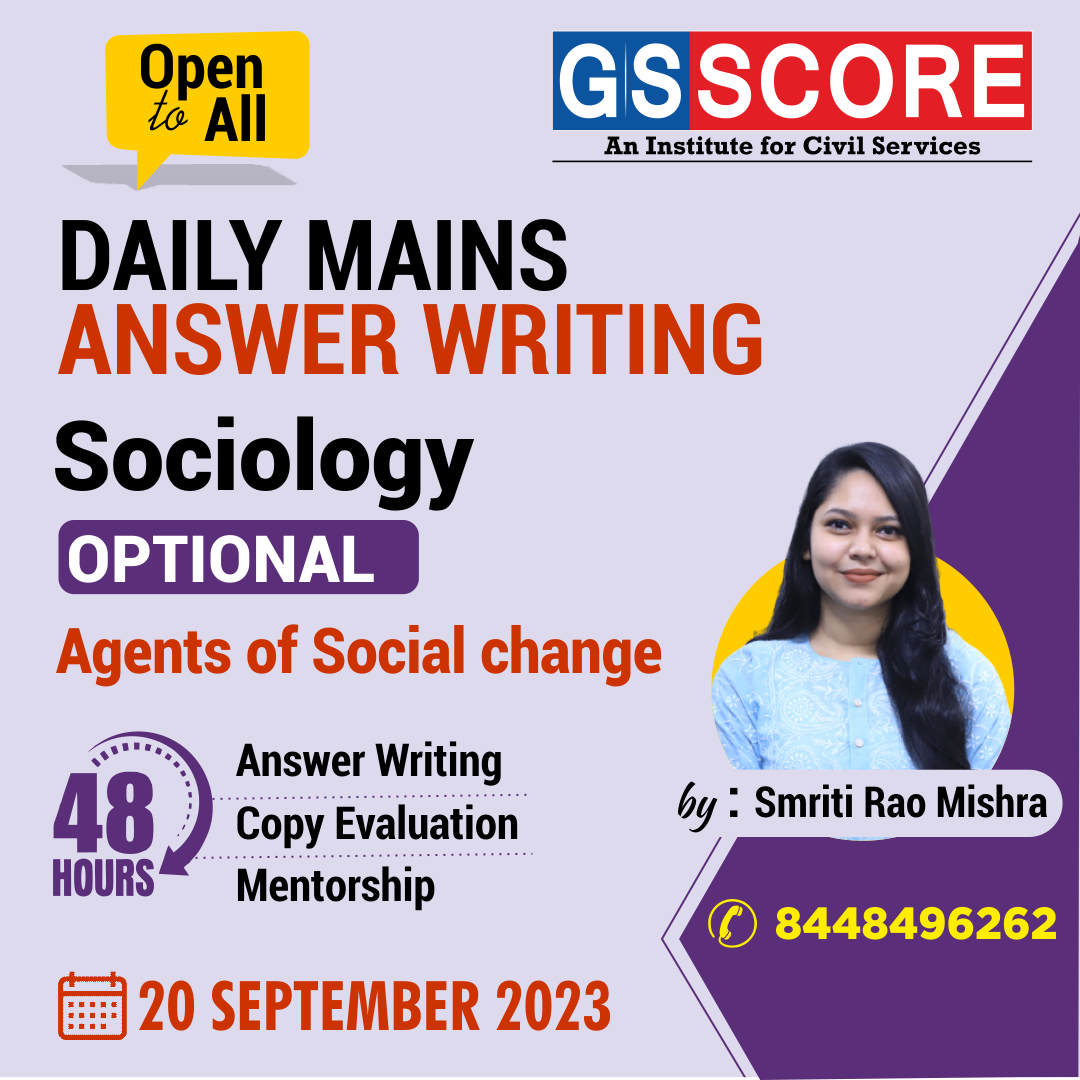


Instruction:
- There will be 2 questions carrying the First Question-is-10 marks Write your answers in 150 words and the Second Question-is-15 marks Write your answers in 250 words.
- Any page left blank in the answer-book must be crossed out clearly.
- Evaluated Copy will be re-uploaded on the same thread after 2 days of uploading the copy.
- Discussion of the question and one to one answer improvement session of evaluated copies will be conducted through Google Meet with concerned faculty. You will be informed via mail or SMS for the discussion.
Question #1. Media is a double edged sword as it plays an instrumental role in moral panic as well as in mass mobilisations. Support your answers with suitable illustrations. 10 marks (150 words)
Question #2. Examine the role of mass transit and mass communication in bridging the gap between rural and urban India. 15 marks (250 words)
(Examiner will pay special attention to the candidate's grasp of his/her material, its relevance to the subject chosen, and to his/ her ability to think constructively and to present his/her ideas concisely, logically and effectively).
STEPS & INSTRUCTIONS for uploading the answers
Step 1 - The Question for the day is provided below these instructions. It will be available at 7:00 AM.
Step 2 - Uploading of Answers : Write the answer in A4 Sheet leaving proper margins for comments and feedback and upload the PDF in MY ACCOUNT section. Click on the option of SUBMIT COPY to upload the PDF.
Step 3 - Deadline for Uploading Answers: The students shall upload their answers by 7:00 PM in the evening same day. The first 50 copies will be evaluated.
Step 4 - Feedback : Mentors will give their feedback for the answers uploaded. For more personalised feedback, join our telegram channel by clicking on the link https://t.me/mains_answer_writing_cse . A one-to-one session will be conducted with the faculty after copy evaluation in 72 Hrs.
Model Answer
Question #1. Media is a double edged sword as it plays an instrumental role in moral panic as well as in mass mobilisations. Support your answers with suitable illustrations. 10 marks (150 words)
Approach:
- Introduction: Role of media in a Democracy
- Media’s role in creating panic: illustrations (Covid 19 has been chosen for this answer-contemporary example)
- Media’s role in mass mobilization (Colonialism & role of media in Indian independence movement-historical example & a case of Vietnam-international example)
- Conclusion: highlight issues with social media that is difficult to regulate
Hints:
The media has been known as the fourth pillar of democracy simply because the media is strong and potent tool to disseminate facts and allow citizens to be better informed about the issues of concern. It can also provide a platform for criticism and debate to ensure that information is tested and examined from all points of view. However, as intended, the media rarely operates as a neutral, objective source of information which makes the media a double-edged sword where in it can play a critical role in mass mobilization at the same time, it can create unnecessary and avoidable panic amongst the citizens.
As recently as during the Covid-19 pandemic, it was seen that the electronic media in India often created panic amongst public instead of informing them to take necessary precautions to protect themselves or manage the symptoms at their residence. Several people began to seek admission in hospitals as soon as they turned positive which also led to shortage of space to accommodate patients who had a genuine requirement for hospitalization.
For instance, there is also an instance of media playing an active role in Vietnam in promoting issues of concern in the case of Thi Vai river. The media reporting not only highlighted the issue but also forced the manufacturer to pay compensation to the affected local residents and businesses. The power of the media to mobilize the masses is best seen during British India where the freedom of the press was legally restricted by way of the Vernacular Press Act, Censorship of Press Act 1799 etc primarily because newspapers and magazines in regional languages flourished & played an important role in forming a collective opinion against the British. Freedom activists illegally shared information through secret radio messages & cyclostyled sheets. Underground publications also started working due to these restrictions.
Thus, it is seen that the managers of media agencies need to actively ensure that information being disseminated is objective, critically sound and informative rather than being biased, lacking in credibility and pushing for political agendas. The larger issue with media today is social media which is much harder to regulate and is not run by any agency in particular that could be regulated/controlled/managed by law. While laws are in place, these are much harder to exercise given the nature of social media per se. Unfortunately, it is seen that fake news, rumours and misinformation spreads faster than reliable information which then requires appropriate discernment at the end of the consumer i.e. the citizen.
Question #2. Examine the role of mass transit and mass communication in bridging the gap between rural and urban India. 15 marks (250 words)
Hints:
The urban population in India has been increasing very rapidly since the last 40 years, along with a commensurate increase in the density of the cities. Apart from this, cities are the centre of economic activity. This leads to a great disparity between rural and urban areas in our country. There are disparities in income, distribution, consumption, health, and quality of life. Thus, it is imperative to connect these urban areas with rural areas; which translates to a higher requirement for mobility.
Mass transit and mass communication have done a lot in this regard to help bridge the gap:
- Recent advancement in technology has done wonders. Digital innovation undoubtedly carries the promise of accelerating rural development. The arrival of the internet, mobile phones, computers, laptops has greatly accelerated the development of rural areas. Access to online markets, food delivery and streaming entertainment for example, have narrowed the gap between urban and rural populations.
- There was always transit between rural and urban areas. Now, mostly huge urban migrations are taking place from rural to urban areas- the primary reason being better living conditions and better earnings. Recently, due to betterment of roads and other means of travel, the floating population has increased tremendously. This has also had a great impact on the economy.
- It is due to mass media and communication that huge tragedies have also been avoided. Alerts for storms and cyclones are given timely based on which people are evacuated and great miseries are avoided. The hugely developed transit system here makes help reach quickly.
But, there is still a lot of scope in which efforts should be put.
- Good schools, good jobs and good hospitals are still a monopoly of urban centers. People in rural areas still need to move out for a better life and then tend to not return. Thus, we need people to work and invest in rural areas so that development can reach in all parts of the country.
- The state of public transport in India is deplorable. India has hardly 12-13 buses per lakh population. This number should be around 100 per lakh, for adequate movement of the people. Also, the condition of buses is not good which leads to a predilection in the favour of private transport.
- The lack of good quality, all-weather roads and infrequent maintenance means that increasing the number of buses is not viable as it would only intensify the congestion in the cities.
- India has one of the highest fatality rate related to road accidents globally. It accounts for about 5 lakh road accidents annually. Major factors for this include scant regard for safety and poor road design. There is a need for better enforcement of laws and better engineering of roads to enhance road safety in India.
Way forward:
- It is imperative to design the mobility system with an eye on socio-economic conditions prevalent in the society, as the present state of society would require inexpensive modes of travel, rather than making huge investments in expensive, unviable projects.
- Keeping in mind the increasing traffic, congestion and lack of parking spaces in the country, there is a need for innovation in the policy-making process.
- With the pandemic, a lot of stress has come to digital communication methods, and these have reached many villages. Government needs to ensure that these developments are continued at the same pace and are not halted now that gradually places are opening up again.
- It is important to encourage entrepreneurship and private sector-led investment, as it is more focussed on innovation. Government needs to guide the private sector and provide opportunities for more public-private partnerships, to leverage investments in public transport.

